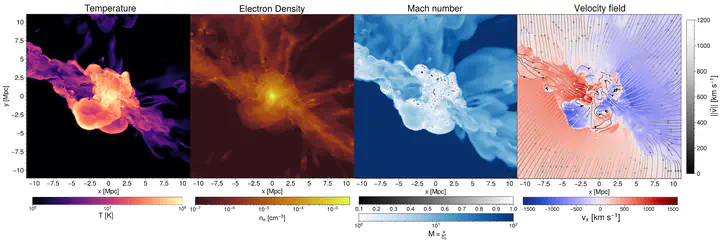
Abstract
Galaxy clusters are currently the endpoint of the hierarchical structure formation; they form via the accretion of dark matter and cosmic gas from their local environment. In particular, filaments contribute grandly by accreting gas from cosmic matter sheets and underdense regions and feeding it to the galaxy clusters. Along the way, the gas in filaments is shocked and heated, which, together with the velocity structure within the filament, induces swirling and, thus, turbulence. In this work, we study a constrained hydrodynamical simulation replica of the Virgo cluster to characterise the velocity field in the two cosmic filaments connected to the cluster with unprecedented high resolution. First, we conduct a qualitative examination of slices extracted from the simulation. We study the temperature, the velocity field, and derived quantities in longitudinal cuts to study the general structure of the filaments and in transverse cuts to study their inner organisation and connection to cosmic matter sheets and underdense regions. Then, we conduct a quantitative study of velocities in Virgo’s filaments by computing the 2D energy spectrum from 1 and 5~Mpc square maps extracted from the slices and centred on the core of the filaments. We show that the velocity field goes from mostly compressive far in the filaments to mostly solenoidal in Virgo’s core. Moreover, we observe that the total energy spectrum in the filaments gains in amplitude and steepens towards Virgo.